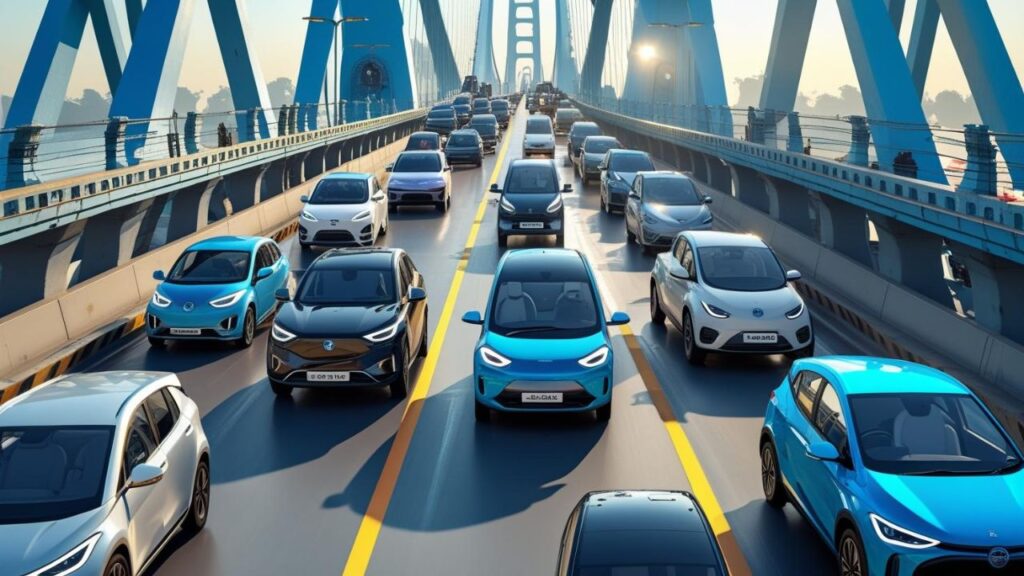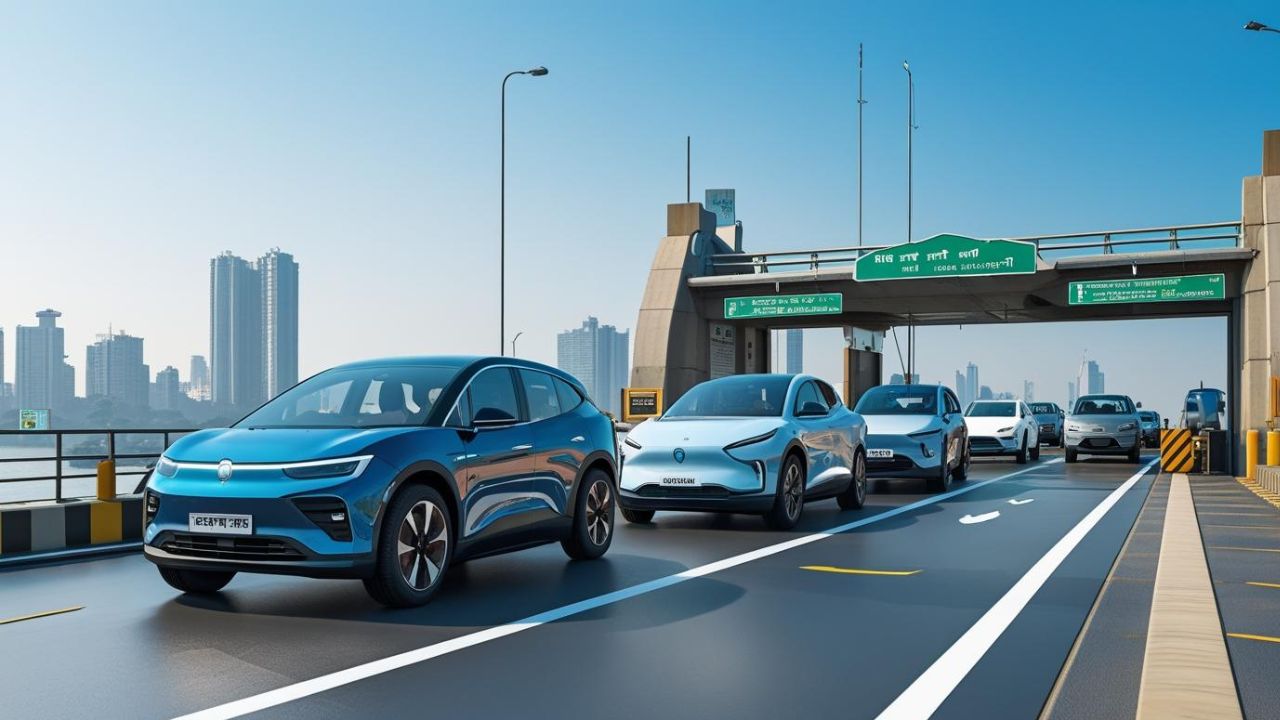The government of Maharashtra has introduced a landmark decision that could change the way people view and adopt electric vehicles in the state. Beginning August 22, 2025, electric vehicles (EVs) are officially exempted from paying toll charges on the Atal Setu, India’s longest sea bridge.
This move is not only a financial relief for EV owners but also a part of Maharashtra’s comprehensive Electric Vehicle Policy 2025, which aims to reduce pollution, encourage eco-friendly transport, and accelerate EV adoption across the state.
Why Toll Exemption for EVs is a Game-Changer
The prices of the EVs and sustaining them are cheaper already compared to the petrol and diesel-fuelled cars. By including exemptions to the tolls, the state has further enhanced EVs to attract more buyers into acquiring. The savings can be substantial in the long-term to frequent users of Atal Setu. Besides, this policy will promote many more citizens to switch to electric mobility, directly helping India reach its objective of having net-zero emissions by 2070.
Scope of the Exemption
The toll exemption covers:
- Electric four-wheelers (M1 category passenger vehicles)
- Electric buses (M3 and M4 category)
Both state-run buses and privately operated EVs are included in this decision. The exemption currently applies at the Shivaji Nagar and Gavan toll plazas on Atal Setu.
This is a critical step because buses form the backbone of public transport in Mumbai and Navi Mumbai. Making them toll-free will not only reduce operating costs for transport operators but also encourage them to adopt electric buses on a larger scale.
Read Also: Tata Sumo 2025 Launched in India – Mileage, Price, Features
The Legal Backbone
The toll exemption is backed by provisions of the Maharashtra Motor Vehicles Tax Act, 1958. The Urban Development Department issued a new notification (No. MRD-3325/C.R.123/UD-7), which updated an earlier January 2025 notification that had mandated tolls for all vehicles crossing Atal Setu. With this amendment, electric vehicles now enjoy a clear advantage over traditional vehicles on this key route.
Part of a Wider EV-Friendly Policy
This project does not only confine itself to Atal Setu. The Highway: In Sustainable Transport Corridor plan in Maharashtra, the EVs will be exempted on:
- Mumbai–Pune Expressway
- Samruddhi Mahamarg
The government is attempting to build such a network of toll-exempt routes by applying toll waivers to several major highways, which can help electric mobility adoption in long journeys.
State Transport Commissioner Vivek Bhimanwar said that the government is actively considering the option of making all electric vehicles exempted to pay toll across the state and this should bring Maharashtra on the map as a leader in electric vehicle adoption in the country.

Why Maharashtra is Pushing Hard for EVs
Several factors explain why the state is going all-in on electric mobility:
- Environmental Concerns
Mumbai and its environs experience air pollution to a large extent mainly dominated by vehiculars emissions. The direct conversion to EV directly helps in the reduction of carbon emissions and also smeeting the air quality. - Economic Advantage to the Citizens
Already EV ownership saves money on fuel cost and maintenance. When there are toll exemptions, there would be greater savings and EVs will prove to be more economical. - Increase to Public Transport
The removal of electric buses into a toll of executions will lead to a reduction in the cost of operating the state transport along with other privately owned bus companies, bringing about a reduction in the fare rates paid by passengers as well. - Consistency with National Goals
The Indian government has placed grandiose EV targets and Maharashtra is one of the most active states in pursuing the course toward a greener economy within the national framework.
Atal Setu: A Strategic Infrastructure Project
The Atal Bihari Vajpayee SewriAtal SetuA bridge connecting Sewri in south Mumbai to Nhava Sheva in Navi Mumbai, the Atal Bihari Vajpayee SewriAtal Setu is 21.8 km long and will be inaugurated in January 2024.
Key Features of Atal Setu:
- India’s longest sea bridge
- Reduces travel time between South Mumbai and Navi Mumbai from 2 hours to just 20 minutes
- Eases congestion on existing road routes
- Supports both commercial and passenger traffic
By waiving the toll fees in EVs on that most important arterial, not only does this show travelers that it is a cheaply priced mode of transit, but also provides an affirmation that the state is serious about green infrastructure.
Read Also: Renault Kiger 2025: Launch, Updates, and Complete Specifications
Financial Impact of Toll Savings
To a frequent commuter, paying toll fees may become a costly activity on a monthly basis. By freeing EVs of the tolls, the government will directly bail a number of users financially.
For example:
Assuming that the commuter drives between Navi Mumbai and Mumbai with Atal Setu, and he/she takes petrol or diesel, then toll charges may amount to thousands of rupees per month.
Now the costs of maintenance are divided by the EV users, saving the whole amount, which ultimately makes the ownership much more lucrative.
This is a cost-cutting factor that might prompt hesitating individuals to switch to use an EV.
Voices from the Ground
Transport operators and the EV owners have hailed the move. It is believed that it will positively affect EV use on highways and increase it significantly.
A commuter in Navi Mumbai said:
This is a big relief I was crossing Atal Setu almost everyday and the toll was a costly affair. “Now, my electric car is that much more a smarter investment.”
The bus operators have equally emphasized that the ruling will reduce their operating cost thus enabling them to purchase more electric buses on strategic routes.
Challenges Ahead
Though the toll exemption is a good idea, there are some flaws to it:
Charging Infrastructure: Highways require fast-charging service stations across Maharashtra to make long-distance travel possible in EVs.
Initial Price of EVs: EVs lie higher in terms of costs than the petrol and diesel vehicles even thought the prices are dropping.
Information Lapse: There are still many citizens that do not understand much about how EVs work, how long batter life is, and the overall long-term impact.
The state government will also have to handle these challenges by means of policy incentives, subsidies and the investments made in infrastructure.
Comparison with Other States
Of course, Maharashtra is not the first state to positively incentivize EVs, but surely one of the most ambitious. Such tax waivers and purchase incentives are also extended by states like Delhi and Karnataka but the toll-free travelling on various highways that Maharashtra proposes marks the first time in the state.
This would pressure other states in India to do likewise, in a competitive pressure to make the whole of India to use EVs.
Future Roadmap
As a statewide toll waiver is under consideration, the long-term plan of EVs in Maharashtra will be:
The expansion of charging network in cities and highways
- Providing subsidies to electric two-whwheelers, three-wheelers and commercial fleets
- Expanding the number of electric buses in the fleets of public transport
- Collaboration with the companies on EV ecosystem development
In such a case, these measures have the potential to turn Maharashtra into a lead state in electric mobility in India.
Quick Facts Summary
| Feature | Details |
| Effective Date | August 22, 2025 |
| Vehicles Covered | Electric four-wheelers & electric buses (state and private) |
| Toll Plazas | Shivaji Nagar, Gavan |
| Legal Framework | Maharashtra Motor Vehicles Tax Act, 1958; Notification MRD-3325/C.R.123/UD-7 |
| Other Highways | Mumbai–Pune Expressway, Samruddhi Mahamarg |
| Future Plans | Statewide toll exemption under consideration |
| Bridge Length | 21.8 km – longest sea bridge in India |
| Impact | Reduced travel costs, cleaner mobility, boost to EV adoption |
Conclusion
The decision to exempt the electric vehicles on Atal Setu by paying no toll is a watershed one with a money saving factor, an environmentally conscious move, and a long term perspective. By breaking down obstacles to movement in the form of toll barriers, the Maharashtra government is providing the people with EVs a potent incentive to remain with clean transport and persuade people to switch to clean mobility.
Such policies are important, as charging infrastructure grows and EVs become more widespread, as it will determine whether Maharashtra will become a green mobility giant. Atal Setu is both a symbol of connectivity and, perhaps, a new source of light in the area of sustainable transport in India, at least, it is hoped.

13 thoughts on “Maharashtra Makes Atal Setu Toll-Free for Electric Vehicles: A Big Push Towards Green Mobility”